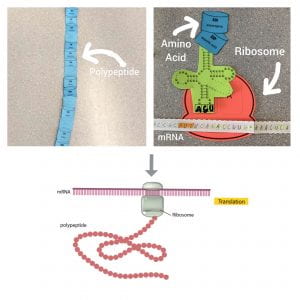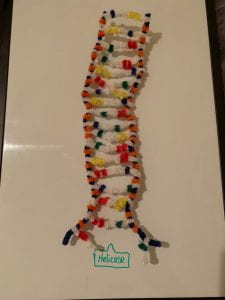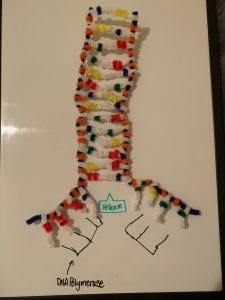DNA vs. mRNA
Messenger ribonucleic acid (mRNA), possesses all the basic characteristics of RNA, and it acts as a complementary strand to one of DNA’s strands. While the composition of DNA and RNA are similar, there are a few differences between mRNA and DNA:

• mRNA is made up of ribose sugars, while DNA is made up of deoxyribose sugars (a ribose sugar that has been de-oxygenated).
• They contain different pyrimidines. DNA utilizes thymine, while mRNA has uracil.
• While DNA is present in the nucleus (of eukaryotes), mRNA will diffuse into the cytoplasm after it’s synthesis.
• DNA is double-stranded, while mRNA is single-stranded.
• mRNA has a short lifespan, while DNA has a long lifespan.
Using pipe cleaners to represent the differences:

Building pipe cleaners to represent this, is very useful. You are able to very easily tell the differences in the structure, as you will have to build both the DNA, and mRNA strands. However, there is some difficulty in observing some differences, such as one being built of deoxyribonucleic acid, while the other is oxygenized, or representing that DNA is present in the nucleus while mRNA is present in cytoplasm after synthesis. Ultimately, I can strongly recommend using pipe cleaners to build both, as it is very helpful for your understanding of both, and helps familiarize you with their shapes in a non-intimidating manner.
Transcription and Translation:
The process of transcription is very similar to DNA replication; however, it will only take place on one backbone, unwinding, complimentary base pairing, joining, all facilitated by the enzyme RNA polymerase. The process of transcription will take the information that is encoded in the gene of DNA, and encode that same information in mRNA.

A crucial piece of transcription, is RNA polymerase (which are large enzymes with multiple subunits), as it will carry out the process of transcribing DNA into RNA. Thus, creating a new RNA molecule through base pairing. First, the RNA polymerase will bind to the start sequence of DNA. Once it has found this codon, the RNA polymerase will separate the strands of a section of DNA (which is called a transcription bubble), which will provide the single stranded template that is needed for transcription (which is referred to as the template strand).


Secondly, the RNA polymerase will read the DNA strand one base at a time, and will concurrently build an RNA molecule through complementary nucleotides, creating a chain (that will go in the 5’ to 3’ direction). Essentially, during this step the elongation of the RNA strand becomes longer, due to an addition of nucleotides. Finally, the mRNA strands will have been copied and paired from the DNA template strand. This involves a stop codon, that will signal that the RNA transcript is complete. It will then cause the transcript to be released from the RNA polymerase.
-

-

During translation, the codons of the mRNA strand are read (in the 5′ to 3′ direction) by tRNAs. Every tRNA contains a set of anticodons (a set of three nucleotides that will bond to the matching bases on the mRNA strand through base pairing), and attached to the top of the tRNA is the complimentary amino acid to the anticodon that it carries. tRNA will then bond to the mRNA strands through the ribosome which is reading the complimentary base codon for it to bond to. Once two tRNAs are present and bonded, their amino acids will also bond together through peptide bonds. This will eventually result in a chain of amino acids (polypeptide), which creates a protein. Translation is composed of three steps: initiaition, elongation and termination.

During initiation, the ribosome reads the mRNA codons, beginning the process once it reads the start codon (AUG).
Next, elongation occurs, where the ribosome will begin to move along the mRNA and continue to read its codons. While reading the individual

codons, a complementary tRNA containing on one of its ends, the anticodon for the mRNA codon, and on the other end, the matching amino acid for the anticodon. Once a second tRNA has bonded to the mRNA strand, the amino acids will also bond together through peptide bonds,

eventually creating an amino acid chain (polypeptide), resulting in a protein. Once both tRNAs have arrived, and both amino acids have bonded together, the first tRNA, will leave, and the second will move to take its place, as the ribosome moves onto the next codon of the mRNA strand.

The third step, termination, is the process where the ribosome reads a stop codon on the mRNA strand, and as there is no complimentary tRNA for a stop codonm, it will inform the ribosome to release the mRNA, thus ending the amino acid chain.


How using pipe cleaners to represent these processes could be useful:
this activity did a good job of representing translation, because we were able to visually understand not only the processes of tRNA and amino acids, but also the reading and pairing of codons. I found it very useful to be able to act out the processes myself, because I was then able to better remember it and deepen my knowledge. I also enjoyed being able to pair the original DNA strand to it’s nucleic base pairings in order to create the copied mRNA strand. However, I think that it could have been more helpful to in corporate the pipe cleaner DNA into this process, as it would allow for a better visual representation of the DNA being copied. I also think that the ribosome created by rRNA and it’s reading of the codons could have been better represented by cutting out the three individual places (mouth, A, and P) to better visualize it’s process. Ultimately, I found this experience very helpful in demonstrating translation and helping me remember its process.

The structure of DNA:
DNA (deoxyribonucleic acid) is found in the nucleus of eukaryotes and the cytosol of prokaryotes, and is made up of a chain of repeating subunits (of monomers), called nucleotides. In each nucleotide, there are three main parts: a phosphate group, a sugar, and a nitrogenous base.

These phosphate groups are what make the DNA (nucleic acid) an acid. Attached to the phosphate groups, are a cycle / ring structured molecule, which is a five-carbon sugar. These alternating phosphate and sugar groups along the sides of DNA are its backbone. While these backbones seem to run parallel to each other, one is in fact the pointing in a different direction (upside down – the left strand is 5’ (prime) to 3’, and the right strand is 3’ to 5’, all on the five-carbon sugars) than the other, thus causing it to be antiparallel. [as shown below]

The five-carbon sugar which would be a Ribose sugar in RNA, becomes a Deoxyribose sugar in DNA, as it contains a hydrogen atom instead of a hydroxyl atom on its two-prime carbon (deoxyribo). The final part of the DNA structure, are the nitrogenous bases. Nitrogenous bases are classified into two different groups: purines and pyrimidines. The two-ringed bases are purines, whereas the one-ringed bases are pyrimidines. Within purines and pyrimidines are four different types of bases. In purines there is adenine, and guanine. In pyrimidines there is thymine, and cytosine. Adenine will always bond with thymine, and guanine with cytosine. This is referred to as complementary base pairing. As pyrimidine will always bond with a purine, it causes DNA to form a spiral / helix, and due to DNA being double stranded, its structure is therefore referred to as double helix.

How modeling DNA structure out of pipecleaners can be helpful:
For me, this activity helped to break down both the structure of DNA and the processes that occur to achieve this structure. The steps in which DNA functions became more clear, however I found that it could have been more useful to use two different colored bonded pipe cleaners to represent the two strands of DNA, instead of beads to represent the 5-carbon sugars. If we could have possibly used blue and orange pipe cleaner pieces connected together to form a DNA strand, then I would have found more clarity in what the beads were supposed to represent. Contrarily, I found that the use of beads as complimentary bases to improve my understanding of how their pairing works greatly, and I am now able to better remember what purines and pyrimidines pair together, and their differences as bases.

When does DNA replication occur?
DNA replication occurs during the synthesis phase of interphase and the mitotic phase of a eukaryotic cell. Interphase is a part of the cell cycle, which will cause DNA will go through three stages of change: first gap (G1), synthesis (S), and second gap (G2). Both the G1 and G2 phase together are recognized as interphase. During the G1 phase, the cell will physically grow larger, copy its organelles, and create molecular building blocks. Next, during the S phase, the cell will synthesize a copy of the DNA in its nucleus, while also duplicating the centrosome (helps separate DNA during mitotic phase). Following this process is the G2 phase, which causes the cell to further grow, creates proteins as well as organelles. Once this phase ends, the mitotic phase will occur. Here, the cell will divide the copied DNA and cytoplasm, thus creating two new cells. Within the mitotic phase, there are two existing processes: mitosis and cytokinesis. Four different stages exist within mitosis: prophase, metaphase, anaphase, and telophase. After both processes have taken place, then the DNA replication will have finished, and is dependent to the cell it is replicating, as to when the next daughter cell will be created.
The steps of DNA replication:
Some of the key components to DNA replication are enzymes, helicase, DNA polymerase, primase, ligase Enzymes are able to speed up reactions as well as build up or break down the items that they act upon.
Beginning at the origin, Helicase is able to “unzip” / unwind the two strands of DNA, by breaking the hydrogen bonds that attach the nitrogenous bases (adenine, thymine, cytosine, guanine). While this process occurs, single stranded binding proteins (SSB proteins) will bind to the separated DNA strands in order to prevent them from coming back together. During this process, topoisomerase will also control the DNA to prevent it from supercoiling (over winding of the DNA). DNA polymerase is then able to replicate DNA molecules in order to build the new strand of DNA, however it is unable to work without a primer. This primer (made up of RNA) is created by primase, which directs DNA polymerase to the point where it should begin to work on both strands of the DNA.
Why the steps of DNA replication occur differently in leading and lagging strands?
DNA polymerase will build the new strand of DNA in the 5’ to 3’ direction, and as DNA strands are antiparallel (left is 3’ to 5’, and right is 5’ to 3’), DNA polymerase will build the left 3’ to 5’ strand smoothly moving forward, while building on the 5’ to 3’ strand will force it to move from right to left, thus having to jump to the newest un-winded right (5’) section, and causing primers to continually be placed at the newest starting point, in order to continue building the DNA.

These two strands are categorized as leading (3’ to 5’), and lagging (5’ to 3’). After DNA polymerase has occurred in lagging strands, it will result in fragmentation between each 3’ 5’ section where it had to jump to the newest un-winded point. These are known as Okazaki fragments. As the primase primers are made up of RNA, ligase is then used to “glue” the gaps between Okazaki fragments, using nucleic bases to seal them. This entire process results in two identical DNA molecules, both being composed of old and new synthesized strands, which can be referred to as a semi-conservative process.
How replicating DNA with pipecleaners could be helpful:
With this activity, to represent complimentary base pairing along with the joining of adjacent nucleotides, I used a DNA strand, and un-winded the H-bonds that bonded the nucleic base acids, and demonstrated the both the helicase and DNA polymerase through drawing around the strand of DNA. This process was accurate in the steps that take place throughout the process of DNA replication, however it was not visually demonstrative in the process.

I found it hard to demonstrate the leading and lagging strands being copied (including the fragments that are created throughout this process on the lagging strand, along with demonstrating the primase that will seal them). While I also found it difficult to properly show the helicase breaking the seal, I think that drawing it going through the DNA strand helped to clarify the process further.
Core Competency Reflection:
How had this unit impacted your creative and critical thinking and communication skills?
This past unit has had a constructive impact on both my creative and critical skills in both my thinking and communicating. Throughout the unit, I encountered many obstacles and challenges, and was forced through this to put my critical and creative thinking into action. When confronted by a challenge, I would first begin by breaking down the question that was troubling me, to a simpler form. If that did not work, I would then refer to previously taken notes. However, if neither of these options worked, it was then that I would communicate my confusion to a pier, or teacher. This would usually result in an explanation to my question, although it would sometimes require a deeper exploration into the subject as well as some creativity in solving the problem from both parties. While math itself teaches one the different functions of numbers, and the laws that go with them, it also teaches life skills such as problem-solving, critical thinking, and communication, which was ultimately demonstrated to me throughout the past unit.



























